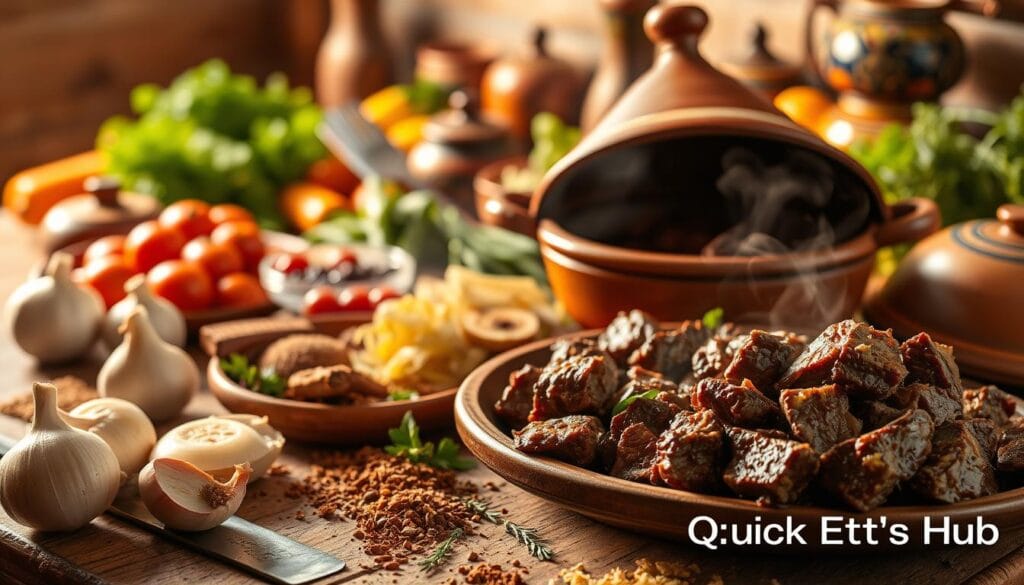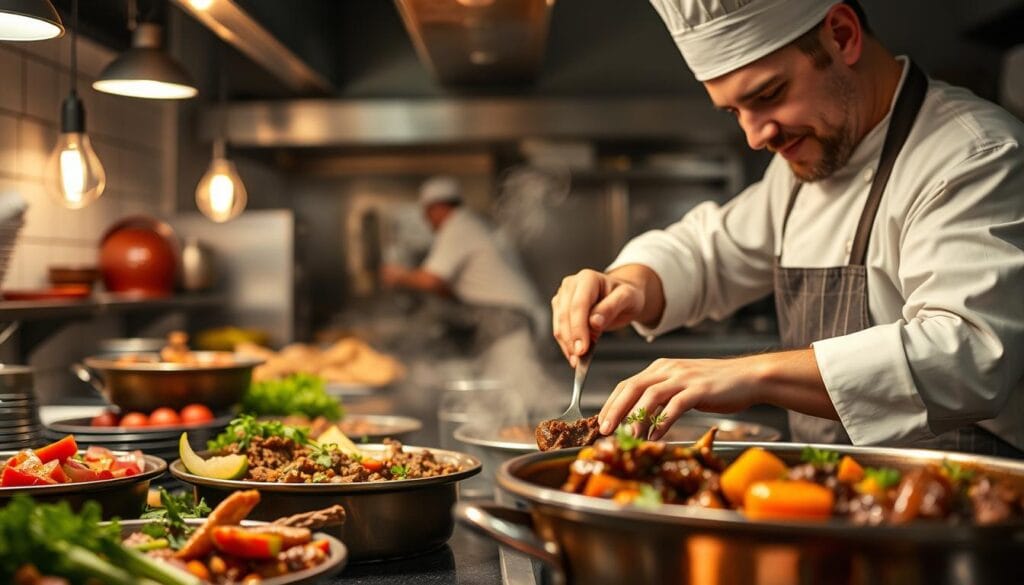Imagine the aroma of exotic spices wafting through your kitchen, transporting you to the bustling souks of Marrakech. This is the magic of Moroccan Beef Tagine, a dish that embodies the heart of Moroccan cuisine. With its origins rooted in traditional slow-cooking methods, this recipe offers a flavorful journey that combines tender beef, aromatic spices, and the convenience of a one-pot meal.
The Tagine pot, with its distinctive conical lid, is more than just cookware—it’s a centuries-old cooking tradition. As the ingredients simmer gently, the pot distributes heat evenly, infusing the beef with a depth of flavor that’s hard to replicate with modern cookware. This labor of love results in fork-tender beef that’s simply irresistible.
What makes this recipe truly special is its focus on beef, avoiding wine and pork to cater to diverse dietary preferences. The blend of spices like ras el hanout, ginger, and saffron creates a symphony of flavors that will leave your taste buds craving more. Whether you’re a seasoned cook or a culinary novice, this beef tagine recipe is a gateway to the rich and vibrant world of Moroccan cooking.
Ready to embark on this culinary adventure? Let’s dive into the step-by-step guide to creating this remarkable dish, where tradition meets practicality in perfect harmony.
Table of Contents
Introduction to Traditional Moroccan Stews
Traditional Moroccan stews, known for their rich flavors and aromatic spices, have a deep-rooted history that dates back centuries. These stews, often cooked in a clay pot with a conical lid, are a cornerstone of Moroccan cuisine. The earthenware pot, or tagine, is designed to distribute heat evenly, ensuring that the ingredients simmer gently and retain their moisture. This traditional cooking method not only enhances the flavor but also adds an authentic, exotic flair to the dish.
The Rich History of Tagine Cooking
The tagine pot has been a staple in Moroccan kitchens for generations, with its origins tracing back to the Berber people. The conical shape of the pot allows steam to condense and return to the dish, creating a self-basting effect that infuses the stew with rich, complex flavors. This slow-cooking process typically takes about 45 minutes to an hour and 15 minutes, resulting in tender ingredients and a harmonious balance of spices.
The heart of Moroccan stews lies in their aromatic spices. Cumin, cinnamon, and ginger are just a few of the key spices that have shaped the cuisine over the centuries. These spices, combined with onions and garlic, form the base of the stew, creating a fragrant and flavorful foundation. As the ingredients simmer, the spices meld together, resulting in a dish that is both hearty and aromatic.
One of the defining features of Moroccan stews is the careful balance of flavors. The slow-cooking process ensures that each ingredient contributes to the overall taste, creating a dish that is greater than the sum of its parts. Whether it’s the subtle sweetness of tomatoes or the warmth of spices, every element plays a crucial role in the final flavor profile. This attention to detail and commitment to traditional methods are what set Moroccan stews apart from other global recipes.
Timing is everything in the preparation of a traditional Moroccan stew. From the initial sautéing of onions and garlic to the slow simmering of the ingredients, each step requires patience and attention. The end result is a dish that is not only delicious but also deeply satisfying, offering a glimpse into the rich culinary heritage of Morocco.
Essential Ingredients for a Flavorful Tagine
Creating an authentic and delicious tagine begins with selecting the right ingredients. Each component plays a vital role in achieving that perfect balance of flavors. Let’s explore the key elements that make this dish truly special.
Choosing the Best Beef Cut
For a tender and flavorful tagine, chuck roast is the ideal choice. Cut into bite-sized pieces, this cut becomes melt-in-your-mouth tender after hours of slow cooking. The marbling in the meat ensures richness and depth, making it perfect for absorbing the aromatic spices.
Aromatic Spices & Vegetables for Depth
The foundation of a great tagine lies in its spices and vegetables. Garlic, ginger, and onions form the aromatic base, while cumin, paprika, and ginger add warmth and complexity. A drizzle of olive oil enhances the overall flavor profile.
| Ingredient | Quantity | Role |
|---|---|---|
| Chuck Roast | 1 ½ pounds | Star protein for tender texture |
| Garlic | 1 tsp | Foundational aroma |
| Ginger | 1 tsp | Spice and warmth |
| Olive Oil | 2 tbsp | Flavor enhancer |
| Cumin | 1 tsp | Earthiness |
| Paprika | 1 tsp | Smoky depth |
“The art of tagine lies not just in the ingredients, but in how they harmonize.”
Each ingredient is carefully chosen to maximize flavor without unnecessary additions. The blend of spices and vegetables creates a symphony of tastes, ensuring a dish that’s both hearty and aromatic. This thoughtful selection is what makes a tagine truly unforgettable.
Preparing Your Tagine Pot or Dutch Oven
When it comes to slow-cooking a delicious beef tagine, the right cookware can make all the difference. Whether you choose a traditional tagine pot or a Dutch oven, understanding how to prepare and use your chosen vessel is key to achieving that perfect, tender result.
Benefits of a Traditional Tagine
A traditional tagine pot is more than just a cooking vessel—it’s an experience. The conical lid is designed to circulate steam, ensuring even cooking and infusing the dish with rich, aromatic flavors. This unique design allows for minimal water usage while maintaining moisture, making it ideal for slow-cooking tougher cuts of meat until they’re tender and flavorful.
Using a tagine pot also adds an authentic touch to your cooking. The earthenware material distributes heat evenly, preventing hot spots that can burn your dish. Plus, the presentation is stunning, making it a great serving piece straight from the oven or stovetop.
Alternate Slow Cooking Methods
While a traditional tagine pot offers unmatched authenticity, a Dutch oven is a fantastic alternative. Dutch ovens are versatile and widely available, making them a practical choice for many home cooks. They retain heat well and can be used on the stovetop or in the oven, providing flexibility in your cooking method.
Both options require attention to heat and water levels. For the best results, maintain a low to medium heat setting and monitor the water to prevent the dish from drying out. This careful balance ensures that your beef remains tender and the flavors meld together beautifully.
| Feature | Tagine Pot | Dutch Oven |
|---|---|---|
| Design | Conical lid for steam circulation | Heavy, tight-fitting lid |
| Material | Earthenware or ceramic | Cast iron or enamel-coated |
| Heat Distribution | Even, radiant heat | Even, retained heat |
| Moisture Retention | Excellent with minimal water | Good with moderate water |
| Use | Stovetop or oven | Stovetop, oven, or camping |
Whether you opt for the traditional charm of a tagine pot or the practicality of a Dutch oven, the key to a successful dish is patience. Allow the ingredients to simmer slowly, letting the flavors develop over time. With the right pot and a little care, you’ll create a dish that’s not only delicious but also visually appealing.
Slow-Cooked Moroccan Beef Tagine: Step-by-Step Instructions
Embark on a culinary journey with this easy-to-follow guide to creating an authentic Moroccan Beef Tagine. By breaking down the process into manageable steps, you’ll achieve a dish that’s both flavorful and visually appealing.
Seasoning and Searing the Beef
Begin by seasoning the beef with a balanced blend of spices. In a bowl, mix together 1 tsp of cumin, 1 tsp of paprika, and a pinch of salt and pepper. Toss the beef cubes in this blend until evenly coated. Let it marinate for at least 30 minutes to allow the flavors to infuse.
Heat 2 tbsp of olive oil in your pot over medium heat. Sear the beef in batches until a deep brown crust forms, about 3-4 minutes per side. This step is crucial for locking in the beef’s juices and enhancing the dish’s flavor profile.
Building a Flavorful Base
Add sliced onions to the pot and sauté until translucent, then incorporate minced garlic for an additional minute. Introduce 1 tsp of grated ginger, stirring well to combine. These aromatic elements form the foundation of your tagine’s flavor.
Stir in 1 cup of beef broth and bring the mixture to a simmer. Reduce the heat to low, cover the pot, and let the stew cook for 1.5 to 2 hours. This slow-cooking process ensures the beef becomes tender and the flavors meld together harmoniously.
| Ingredient | Quantity | Role |
|---|---|---|
| Beef | 1 ½ lbs | Star protein for tender texture |
| Garlic | 3 cloves | Flavor depth |
| Ginger | 1 tsp | Spice and warmth |
| Olive Oil | 2 tbsp | Flavor enhancer |
| Cumin | 1 tsp | Earthiness |
| Paprika | 1 tsp | Smoky depth |

By following these steps, you’ll create a dish that’s not only delicious but also rich in tradition. The slow-cooking method ensures tender beef and a flavorful stew, making it a perfect meal for any occasion.
Tips for Achieving Tender, Flavorful Beef
Achieving tender, flavorful beef in your tagine is a skill that elevates the dish from ordinary to extraordinary. By following a few simple tips, you can ensure your beef is perfectly seasoned and cooked every time.
Mastering the Art of Seasoning
Seasoning is where the magic begins. Start by selecting the right cut of beef, such as chuck roast, which is ideal for its fat content and tenderness. Coat the beef evenly with a blend of spices using tsp measurements to avoid overpowering the dish. Let it marinate for at least 30 minutes to allow the flavors to infuse deeply into the meat.
When it comes to salt and pepper, use them sparingly but effectively. A light hand allows the natural flavors of the beef and spices to shine without overwhelming the dish. Remember, you can always add more seasoning, but it’s harder to remove excess.
Ideal Cooking Times for Succulent Meat
Slow cooking is key to tender beef. Aim for a cooking time of about 2 hours, ensuring the beef simmers gently. This allows the connective tissues to break down, resulting in tender succulent meat. Monitor the cooking time closely to avoid overcooking, as this can make the beef tough.
Keep the beef in chunk form to maintain texture. The natural fat in the chuck roast will enrich the overall flavor of the tagine, making each bite juicy and flavorful. For a thicker sauce, consider uncovering the pot for the last 20 minutes of cooking to reduce the liquid naturally.
“The art of tagine lies not just in the ingredients, but in how they harmonize.”
By following these tips, you’ll consistently achieve a dish that’s both delicious and visually appealing. Whether you’re a seasoned cook or a culinary novice, these practical tips will guide you to perfection every time. For more inspiration, check out our rabbit tagine recipe for a unique twist on this classic dish.
Optimizing Slow Cooking Techniques
Mastering the art of slow cooking involves careful attention to heat and liquid levels. This ensures your dish develops a rich, velvety texture without drying out.
Adjusting Heat and Liquid Levels
Maintaining the right balance is crucial. Start with low to medium heat to prevent scorching. Use about 2 cups of water initially, adjusting as needed to keep the stew consistent.
Monitor the liquid levels closely. If the stew begins to thicken too much, add water in half-cup increments. This ensures the beef stays tender and the flavors remain balanced.
Small adjustments in time and temperature can make a big difference. Extending the cooking time by 30 minutes can enhance flavor depth, while lowering the heat prevents overcooking.
A steady, low heat is key to achieving succulent beef and a rich sauce. This method allows flavors to meld beautifully, creating a dish that’s both hearty and aromatic.

Serving Suggestions and Side Pairings
Now that your Moroccan Beef Tagine is ready, it’s time to think about how to present it for the best dining experience. The right sides and garnishes can elevate this dish from delicious to extraordinary.
Pairing with Couscous or Rice
Couscous is a classic choice for serving with tagine, as it absorbs the flavorful sauce perfectly. For a heartier option, try pairing it with a side of fluffy rice. Both options complement the dish beautifully and help soak up the rich, aromatic broth.
Creative Garnish and Presentation Ideas
Add a burst of color and freshness by garnishing with chopped olives, fresh herbs like parsley or cilantro, or even a sprinkle of toasted almonds. These touches not only enhance the visual appeal but also add a delightful contrast in textures and flavors.
| Side Option | Description | Why It Works |
|---|---|---|
| Couscous | A traditional North African staple | Absorbs the flavorful sauce |
| Rice | Fluffy and light | Provides a neutral base for the dish |
| Roasted Vegetables | Seasonal vegetables roasted to perfection | Offers a nice contrast in texture |
| Flatbread | Crispy or soft bread | Perfect for scooping up the sauce |
These serving suggestions will help you create a well-rounded and visually appealing meal. Whether you’re serving it for a special occasion or a cozy family dinner, the right presentation can make all the difference. Elevate your dining experience with these thoughtful pairings and garnishes!
Leftover Storage and Freezing Tips
Once you’ve enjoyed your delicious beef tagine, it’s important to store any leftovers properly to maintain their flavor and texture. This dish actually tastes better the next day, as the flavors continue to meld together.
Maximizing Flavor in Leftovers
To keep your tagine fresh, let it cool completely before refrigerating. Transfer the cooled stew to an airtight container and store it in the refrigerator for up to 3 days. For longer storage, place the container in the freezer, where it will keep for 3 to 4 months.
When reheating, use gentle heat on the stove or in the microwave. If the stew seems too thick, add a cup of water or broth to restore its consistency. This ensures the texture remains tender and the flavors stay vibrant.
| Storage Method | Duration | Instructions |
|---|---|---|
| Refrigeration | Up to 3 days | Store in an airtight container after cooling. |
| Freezing | 3 to 4 months | Place in a freezer-safe container or bag. |
| Reheating | – | Use low heat or microwave; add liquid if needed. |
Consider making a large batch of this recipe, as it’s perfect for meal prep. The convenience of having a ready-to-eat meal on hand makes it a practical choice for busy days. By following these storage tips, you can enjoy your beef tagine for several meals without compromising on taste or quality.
Conclusion
Your journey to crafting an authentic Moroccan Beef Tagine is complete. This traditional dish, with its rich history and aromatic spices, offers a flavorful escape to Morocco’s culinary heart. By carefully selecting quality ingredients like chuck roast and blending spices such as cumin, ginger, and paprika, you’ve created a dish that honors Moroccan heritage.
The slow-cooking process, whether in a traditional pot or Dutch oven, ensures tender meat and a harmonious meld of flavors. Each step, from searing the beef to adjusting liquid levels, has been detailed to guide you effortlessly. This recipe, free from wine and pork, respects diverse tastes while staying true to its origins.
With thoughtful preparation and patience, you’ve crafted a dish that stands out. Share your creation and enjoy the satisfaction of a meal rich in tradition and flavor. This beef tagine is more than a recipe—it’s a celebration of Moroccan cuisine’s simplicity and depth.

